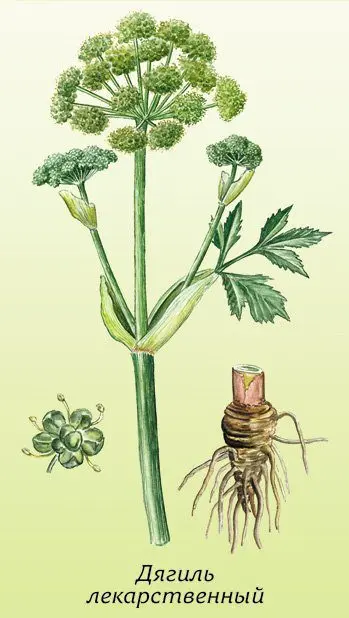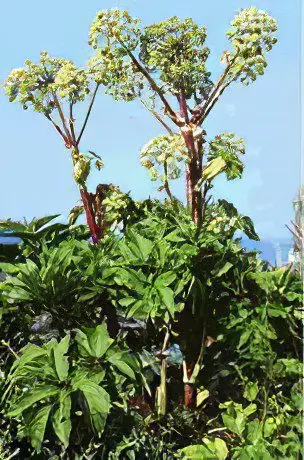Contents
Benefits and uses of angelica root and extract
Description of the piper

Angelica is an unusual umbrella plant, which often reaches a height of more than two meters. The thick, rounded stem is hollow inside, and very branched in the upper part. The large, smooth leaves of this herbaceous plant are considered doubly pinnate. Very small flowers are greenish-white. They are collected in spherical umbrellas of complex shape, in which there are from 20 to 40 rays. Such original umbrellas do not have a common typical wrap. The fruit is presented in the form of a two-seed.
Angelica blooms from June to the very end of August. Fruit ripening occurs in August and September. The plant is very common in Russia and Europe. It can often be found in Siberia and the Urals. It prefers to settle on moist soils along rivers, along ravines, in swampy forests and swamps. For medicinal use, powerful rhizomes with roots are collected. After digging, they should be washed well in cold water, and then cut into pieces of the desired size. Drying raw materials is recommended in the open air in the shade.
Useful properties of angelica
Large rhizomes and roots of angelica contain a lot of organic acids, carotene, wax, bitter and essential tannins, as well as essential angelic oil, resins, starch, phytoncides, furocoumarins and coumarins. Due to this exceptional composition, in case of overdose, they can cause serious toxic and allergic reactions.
The plant has not only anti-inflammatory and diaphoretic properties, but also boasts the ability to enhance the motor and secret functions of the gastrointestinal tract. Amazing angelica quickly reduces or completely eliminates negative fermentation processes in the human intestines, while relieving spasms. Umbrellas also have an expectorant effect in various inflammations of the respiratory system.
The use of angelica
The presented plant is excellent for chronic colitis and gastritis. Numerous preparations based on angelica are indicated for the treatment of respiratory diseases, bronchitis and laryngitis. With stomatitis and gingivitis, they are prescribed in the form of rinses. With regular performance of procedures, these diseases recede. You can also use angelica in the form of infusions as a diuretic or choleretic agent.
Various decoctions of angelica roots are useful for insomnia, severe exhaustion of the nervous system, acute or chronic neuralgia, and also for bronchial asthma. The products have a relaxing effect when aromatizing baths. A special alcoholic tincture of the plant is in most cases used externally for gout and rheumatism. In ancient times, the roots were used as a natural flavoring agent and an incomparable spice.
One of the ways to prepare angelica can be called the following. For 3 st. l. dry and well-chopped herbs take 2 cups of boiling water. We insist this delicious mixture for at least two hours, and then filter. Take the infusion should be half a glass 4 times a day before each meal.
Piper root

In the autumn period, roots with rhizomes are collected. They are dug up, then cut into small pieces and dried for a long time under sheds in the open air, so that direct sunlight does not fall. To prepare a healing decoction of angelica roots, 100 ml of water will require no more than 10 grams of raw materials. Such an excellent remedy is indicated for bronchitis, hepatitis, laryngitis, and also for other no less dangerous respiratory diseases.
Many doctors recommend taking a decoction of the plant for gastritis, flatulence and duodenal problems. It perfectly helps to restore the gastric mucosa after tightening ulcers. This remedy is distinguished by its anthelmintic, antitumor and antispasmodic properties. From it you can make compresses for the treatment of not only gout and rheumatism, but also toothache.
Healing tincture of the roots can be drunk with neuroses and dangerous liver diseases. If you drip the juice of the roots into the hollow of a diseased tooth, then it will act no worse than a modern anesthetic drug. All funds from the roots of angelica can boast of an antipyretic, tonic effect on the human body. They easily relieve headaches, relieve feverish conditions and relieve joint pain.
Piper extract
The magical plant angelica has been used since ancient times by our ancestors. Previously, with the help of this unsurpassed plant, plague and other deadly ailments were cured. The wonderful extract of angelica is one of the miraculous remedies in folk medicine. This health-improving drug tends to have a therapeutic beneficial effect on almost every organ of the human body. It is effective in the treatment of diseases of the spleen and liver.
Angelica extract also helps to restore the functioning of the central nervous system in a minimum amount of time. Such an amazing plant has a positive effect on the gastrointestinal tract, which is important in the body, and the responsible cardiovascular system. After completing the full course of treatment with this extraordinary remedy, there is a wonderful appetite, as well as full digestion and assimilation of all components from food. At the same time, this drug is able to quickly normalize blood pressure.
Angelica extract is indispensable in the fight against various dysfunctions of the human body. These include serious functional disorders of the central nervous system. Women who have any problems against the background of inflammatory processes in the female genital area should undergo a long course of treatment with this remedy. In combination with modern therapy, you can permanently get rid of recurrent gynecological ailments.
Types of angelica:

The fantastic medicinal plant angelica includes several main species that have been widely used since ancient times to treat many diseases.
Angelica forest. This biennial herb grows up to two meters in height. It has a short thick rhizome. When fractured, an interesting white juice is released, similar in consistency to milk. The upright bare stem is very thick, it is presented in a fistulose form. The oblong leaves of the plant can be both double- and thrice-pinnate. Small white flowers are always collected in complex umbrellas. Their diameter does not exceed 17 cm.
The fruit is presented in the form of a small two-seed. Fresh mashed rhizomes and stems have a bitter taste and a strong specific smell. This type of angelica blooms from June to the end of August. It grows in wet meadows, along the gently sloping banks of streams and rivers, as well as among shrubs. The plant is common in Russia and the CIS countries almost everywhere.
Angelica marsh. The presented type of plant in height does not exceed one meter. This herbaceous perennial with a hollow angular-furrowed stem and large pinnately dissected leaves has oblong oval-shaped fruits, the length of which is 5 mm. In diameter, umbrellas reach 7 cm, they have from 8 to 30 rays. The white petals are broadly ovate. An elegant wrapper consists of many linear-lanceolate leaves. Marsh angelica blooms all summer, from late May to mid-August.
The plant is found in Ukraine and Belarus, in the territories of the European part of Russia and in Eastern Siberia, as well as in Central Asia. As usual, it prefers damp meadows and swampy river banks.
Angelica Chinese. This umbrella perennial is not very tall. It has dense powerful rhizomes, a hollow stem and large fleshy leaves. Small flowers form healing umbrellas. Such a medicinal plant has absorbed exceptional healing components. Chinese angelica is found in the popular dietary supplement “Lian-Yang”, which today is very widely used to effectively treat respiratory diseases, gynecological ailments and gastrointestinal pathologies, as well as other chronic problems.
Contraindications of piper
Due to the photosensitizing properties of the plant, direct sunlight should be avoided while using the herb. It is necessary to strictly monitor the prescribed doses, avoiding overdoses.









